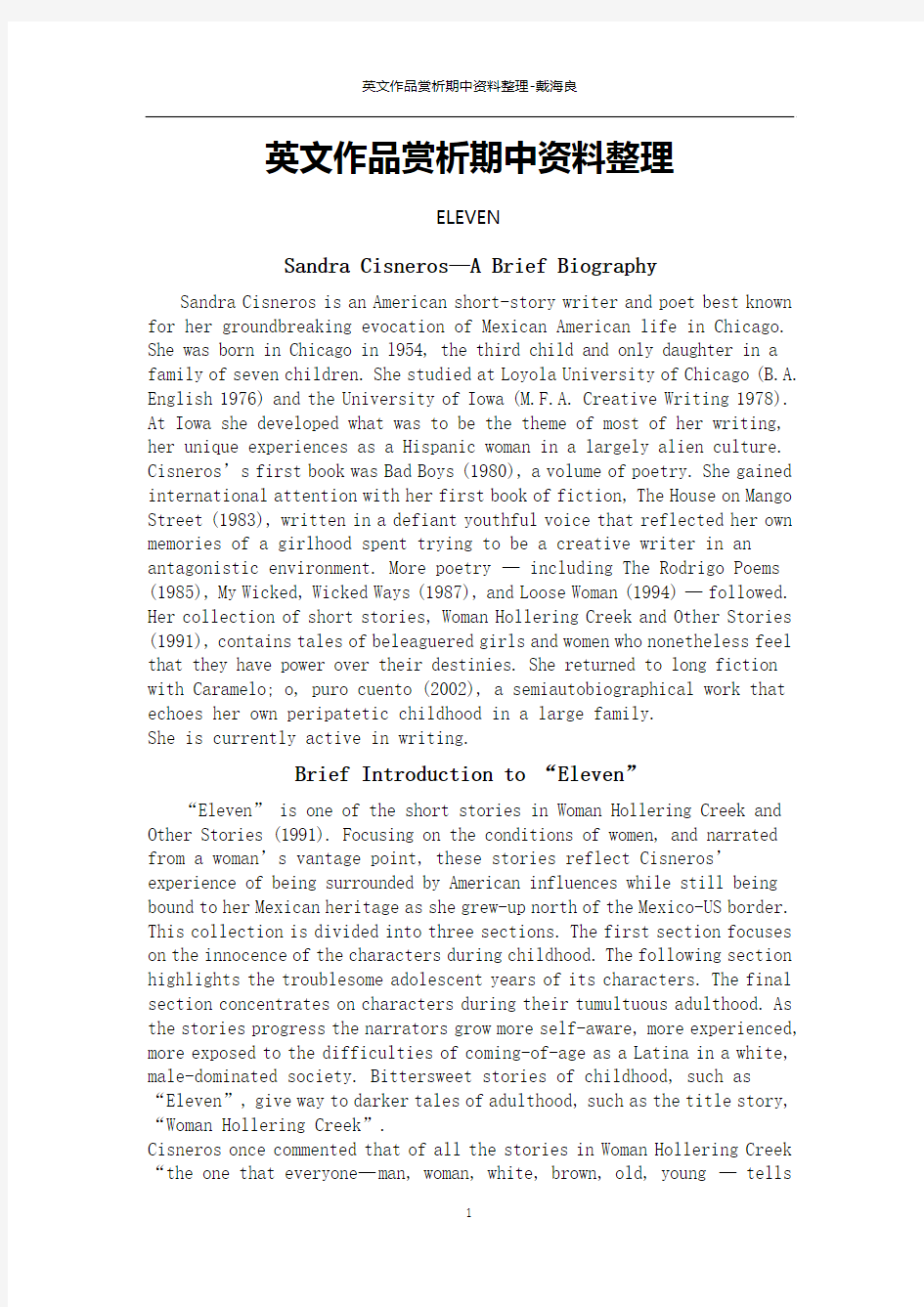英文作品赏析期中资料整理

- 1、下载文档前请自行甄别文档内容的完整性,平台不提供额外的编辑、内容补充、找答案等附加服务。
- 2、"仅部分预览"的文档,不可在线预览部分如存在完整性等问题,可反馈申请退款(可完整预览的文档不适用该条件!)。
- 3、如文档侵犯您的权益,请联系客服反馈,我们会尽快为您处理(人工客服工作时间:9:00-18:30)。
英文作品赏析期中资料整理
ELEVEN
Sandra Cisneros—A Brief Biography
Sandra Cisneros is an American short-story writer and poet best known for her groundbreaking evocation of Mexican American life in Chicago. She was born in Chicago in l954, the third child and only daughter in a family of seven children. She studied at Loyola University of Chicago (B.A. English 1976) and the University of Iowa (M.F.A. Creative Writing 1978). At Iowa she developed what was to be the theme of most of her writing, her unique experiences as a Hispanic woman in a largely alien culture. Cisneros’s first book was Bad Boys (1980), a volume of poetry. She gained international attention with her first book of fiction, The House on Mango Street (1983), written in a defiant youthful voice that reflected her own memories of a girlhood spent trying to be a creative writer in an antagonistic environment. More poetry — including The Rodrigo Poems (1985), My Wicked, Wicked Ways (1987), and Loose Woman (1994) —followed. Her collection of short stories, Woman Hollering Creek and Other Stories (1991), contains tales of beleaguered girls and women who nonetheless feel that they have power over their destinies. She returned to long fiction with Caramelo; o, puro cuento (2002), a semiautobiographical work that echoes her own peripatetic childhood in a large family.
She is currently active in writing.
Brief Introduction to “Eleven”
“Eleven” is one of the short stories in Woman Hollering Creek and Other Stories (1991). Focusing on the conditions of women, and narrated from a woman’s vantage point, these stories reflect Cisneros’ experience of being surrounded by American influences while still being bound to her Mexican heritage as she grew-up north of the Mexico-US border. This collection is divided into three sections. The first section focuses on the innocence of the characters during childhood. The following section highlights the troublesome adolescent years of its characters. The final section concentrates on characters during their tumultuous adulthood. As the stories progress the narrators grow more self-aware, more experienced, more exposed to the difficulties of coming-of-age as a Latina in a white, male-dominated society. Bittersweet stories of childhood, such as “Eleven”, give way to darker tales of ad ulthood, such as the title story, “Woman Hollering Creek”.
Cisneros once commented that of all the stories in Woman Hollering Creek “the one that everyone—man, woman, white, brown, old, young — tells
me, 'oh, that happened to me.’” is “Eleven”. In this pi ece, the birthday of Rachel, the narrator, is ruined by a heartless teacher who forces her to claim responsibility for an ugly, stretched-out sweater abandoned in the coatroom. Despite Rachel’s protests that it is not hers, the teacher gets angry and forces her to wear it. This incident is humiliating and traumatic for the child whose expectation to grow up and be respected is frustrated.
1.What they don’t understand about birthdays and what they never tell you is that when you’re eleven, you’re also ten, and nine, and eight, and seven, and six, and five, and four, and three, and two, and one. Who are “they”?
“They” refer to the adults. Parents and teachers who represents power and authority.
2.What they don’t understand about birthdays and what they never tell you is that when you’re eleven, you’re also ten, and nine, and eight, and seven, and six, and five, and four, and three, and two, and one. Who are “you”?
“You” refers to the reader. By addres sing the reader directly, the narrator succeeds in involving the reader into the story thus creating an immediate effect.
3.What concrete images are used to describe the abstract idea of growing up? What are the similarities between the images?
Concrete images such as “layers of onion”, “tree rings” and “wooden dolls” are used to describe the abstract idea of growing up. The similarities between these images are that they grow big gradually, each bigger one containing the smaller one.
4.What simile is used to describe her eleven years? How does the narrator feel about being eleven?
The simile used is “pennies in a tin Band-Aid box”. She feels that her possession of eleven years is as few as her possession of pennies rattling in a large box. As an eleven-year-old girl, she feels inadequate in front of the adult.
5.What effect is achieved by repeating “not mine”? What difference would it make if the sentence were “It’s not mine”?
The narrator dare not speak for herself. She merely murmurs the truth repeatedly and silently to herself. She gives the reader an impression that she is shy, and feels intimidated by the authority. If the sentence is “It’s not mine”, it will be a voice of assertiveness and protest.
